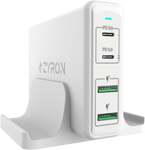All time low on the 156W Max Desktop charger. Part of our Jingle Sale. More products will be added throughout the month.
Features:
⚡4 in 1 CHARGING STATION⚡ Multi USBC Charging Dock with 2x USB-C Ports equipped with Power Delivery 3.0/2.0 to fast charge your laptops, smartphones, tablets and many other USB-C powered devices at 45W/65W/100W. Delivers up to 5V/3A, 9V/3A, 12V/3A, 15V/3A, and 20V/5A via single USB-C port. The Dual USB-A ports delivers up to Quick Charge 18W each and supports fast charging protocols QC 3.0, QC 2.0, AFC, SFC, 2.4A
⚡100W USB-C CHARGER⚡Compatible with MacBook (16"/15" MacBook Pro), Dell XPS 13/15/17 Dell Vostro 5471 and HP Spectre TPN-Q178, Lenovo, Microsoft Surface, HP, iPhone 15/15 Pro/15 Pro Max, 11 / 11 Plus / XS / XS Max / XR / X / 8 / 8 Plus, Switch, Huawei, Xiaomi, Samsung Galaxy S21/S21+/S21Ultra/S20/S20Ultra/S10e / S10 / S10 Plus / Note10 / Note10 Plus and many more devices that support USB-C Power Delivery
⚡SAMSUNG FAST CHARGER⚡Supports PPS charging and Samsung Fast Charging 2.0 at 45W and 25W. Charge 2 Samsung S23/S22/S21/S20 Plus Ultra simultaneously using the dual USB-C ports
⚡PORTABLE DESKTOP CHARGER⚡Extremely compact and portable desktop charging station. It can easily replace 2 traditional bulky laptop and 2 wall chargers. Deskpod can charge 2 laptops simultaneously at 60W each. With a size of 113x80x28.5mm and a weight of 306 grams, you can easily carry it to your business or family trips. Use the charging stand to place your iPhone or iPad/tablet to keep your desktop clean
⚡SAFE CHARGING⚡Multiple Safety features like surge, overcharging, overcurrent and overheating protection to keep your connected device safe. This 100W PD charger has Power Factor Correction (PFC) inside to improve efficiency, green energy
⚡CERTIFIED⚡DESKPOD is SAA Certified (SAA-200164-EA) 100W USB-C PD Charger that can deliver up to 156W Max Output. Also certified by CE, FCC, RoHS, CB, ETL, PSE which makes the desktop charger safe for use worldwide
⚡WARRANTY⚡2 Years Warranty, 30 days money back guarantee and Customer Service with a quick response within 24 hours
⚡IN THE BOX⚡1x Deskpod Charger, 1x 1m AC Figure 8 Power Cable, 1x User Manual, 1x Charging Stand, 1x 100W USB-C to USB-C Cable 1m USB-IF Certified TID: 2541


Does this support quick charging (18w each?) of 2 or 3 devices at once?
Thoughts on this one, ozbargainers? Better options out there?